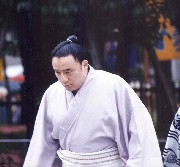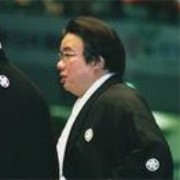| Brothers in Sumo – part one Brian Lewin |
 |
NHK & the Ozumo
English Broadcast
Mark Buckton
A visit to NHK, years of watching the show and the opinions of our Ed-in-Chief
Hanging With the Rikishi
Barbara Ann Klein
Barbara Ann Klein recounts her experiences with the “boys” in a pictorial diary series
| Rikishi of Old Joe Kuroda |
 |
Sumo Exhibit at the
Edo-Tokyo Museum
Barbara Ann Klein
SFM’s Editor takes in the exhibit celebrating 80 years of the Japan Sumo Association at this famous Tokyo museum
| Heya Peek John Gunning |
 |
| SFM Interview Dave Wiggins sits down |
 |
Photo Bonanza
What a collection – All-Japan Sumo Tournament, Hakkaku-
beya visit and sumo exhibits at the Edo-Tokyo Museum
Kyushu Basho Review
Lon Howard
Lon gives us his Kyushu Basho summary, along with the henka sightings results, and his take on the year in brief
Lower Division Rikishi
Mikko Mattila
Mikko Mattila covers lower division ups and downs
| Hatsu Basho Forecast Pierre Wohlleben & Mark Buckton |
 |
Sumo 101
Eric Blair
Eric explains all you need to know and then some about the Kokugikan building – the mecca of sumo
| Kimarite Focus Mikko Mattila |
 |
Minusha
John McTague
John’s unique bimonthly view of news from outside the dohyo
Online Gaming
Eric Blair
For the lowdown on Guess the Kotomitsuki – baby of SFM’s John Gunning
Kokugi Connections
Todd Lambert
Todd’s bimonthly focus on 3 of the most interesting sumo sites today
| Fan Debate Intra heya bouts – |
 |
SFM Cartoons
Stephen Thompson
In the second of our cartoon bonanzas, sit back and enjoy ST’s offerings
Let’s Hear From You
What was it that made you a sumo fan? American Todd Defoe tells all
Readers’ Letters
See what SFM readers had to say since our last issue
Sumo Quiz
The Quizmaster
Answer the Qs and win yourself next basho’s banzuke.
In several years’ time he would pass Kakureizan, and in July of 1984 a little more history was made when, for the first time, three siblings had achieved

Shikoroyama-oyakata, the former Terao
sekitori status. Perhaps to mark that occasion, he changed his shikona to Genjiyama. He quickly reconsidered however, and reverted to Terao the following basho. Two years later, and again almost three years after that, two of the brothers would make history again – this time, Sakahoko and Terao. First, in the September 1986 Aki basho, they became the first brothers to win sansho together; with the 1989 Haru basho, Terao caught up with his brother and they became the first simultaneous sibling sekiwake.
While some same-sport brothers show clear similarities
Differences showed in longevity as well. Sakahoko was relatively average in that respect, lasting just over 14 years and retiring a bit after his 31st birthday, in the 1992 Aki basho, taking the toshiyori name Kasugayama, before taking over as Izutsu for his retiring father two years later.

Izutsu-oyakata, the former Sakahoko
Towards the end of his career in the autumn of 2000, Terao would have a rather unique experience, facing future yokozuna Asashoryu on the dohyo in juryo. On the face of it, there is nothing particularly unusual about that... except that when Terao started sumo in 1979, Asashoryu had not yet been born.
The almost-forgotten brother, Kakureizan (also known for a time as Tsurunofuji), retired in January 1990. Capitalizing on his youngest brother’s popularity, he later started Sumochaya Terao, a chanko nabe restaurant specializing in Izutsu-beya style chanko. The restaurant is peppered with memorabilia relating to the three brothers, but emphasizing
Next Home
